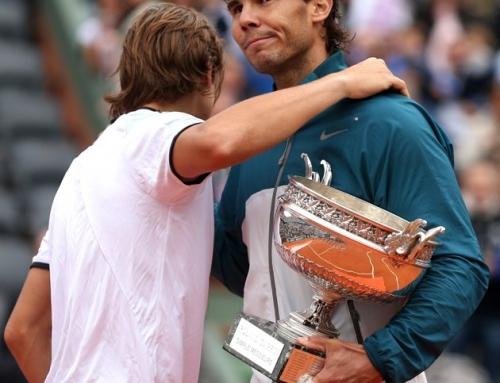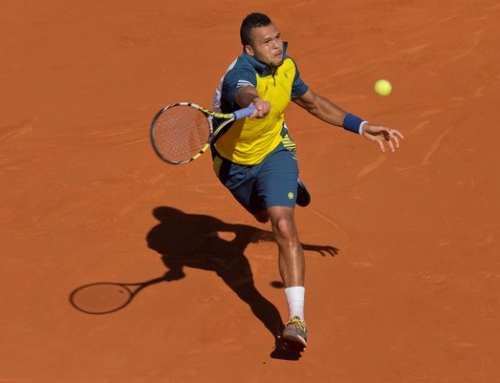 Before we reflect on what kind of accomplishment Rafael Nadal made with his record equaling sixth win, we should take time to think about the era of Borg.
Before we reflect on what kind of accomplishment Rafael Nadal made with his record equaling sixth win, we should take time to think about the era of Borg.
Borg played in the cusp of two eras, the transition that lead to twenty years of revolution in tennis. Perhaps the biggest revolution was the one in 1968 and the advent of professional tennis. Up to then, tennis was this quaint sport that was amateur only. It wasn’t the US Open or the French Open but the US National Championships and the French National Championships.
For some peculiar reason, perhaps similar to the Olympic idea, tennis was amateur only. This meant a good amateur could only play tennis a few years, then if they wanted to make a living, they had to turn pro. And, in those days, you didn’t turn pro as much as you were selected as part of an elite group that would travel the world playing exhibitions. Thus, the ranks of pros were tiny, perhaps numbering no more than 100 players, and really, only 20-30 that could make money.
John McEnroe points to Rod Laver as the only player ever to achieve the Grand Slam twice, but he had many things that made it possible for him to do it in that era and that make it tougher, though not impossible, to do it now.
First, he won his first Grand Slam as an amateur. Players that were senior to him like Ken Rosewall or Pancho Gonzales were not permitted to play the Slams, and so the best talent of the day didn’t play. He had limited competition. To be fair, there’s only been one junior to win a junior Grand Slam showing that it’s very difficult to play your best tennis when everyone around you is advancing so quickly.
Second, there were only a handful of countries producing good players. There was Australia, the US, France, the UK, and maybe 2-3 other countries. The pool of talent was very small. And before there was Bollettieri, there was Harry Hopman who trained “generations” of great Aussie players. This may have resembled the early Japanese volleyball players who were trained to dive to get a volleyball, a skill so unladylike, that no other country had even thought it possible. Hopman brought a level of fitness and camaraderie that allowed the best Aussies to compete with one another.
Third, three of the four Slams were played on grass. Sure, the Europeans generally played on clay, but they lacked many of the skills needed to excel on grass. If you were great on grass, you would have been dominant on three Slams. Imagine how many Slams Sampras would have won if 3 of the 4 majors were played on grass.
Once professional tennis was ushered in, many other countries began to participate. It made financial sense to do so since players could earn their own keep. The tennis landscape changed. The Australian dominance began to fade as players like Laver and Rosewall got older without a large cadre of youngsters to replace them.
Grass began to fade as a surface that tournaments were played on. And players like Borg and Vilas began winning on surfaces outside of clay. Although Borg didn’t invent topspin, he certainly showed how important it would be to the modern game. In the old days, a player slicing an approach shot to the net would generally be greeted with a lob. The flat passing shot was not reliable enough. The dipping passing shot was practically unknown. The way to win tennis was at the net. Even clay courters, like Borg, came to net.
The 1970s brought with it technology and a change to baseline play. The top players of the day, Borg, Connors, and Evert were baseliners. There were still serve and volleyers, to be sure, including John McEnroe and Martina Navratilova, but baseliners began to hit harder, hit with topspin, and the flat players of the day were befuddled by these high arcing balls and players that could hit 20-30 shots without missing.
Although Borg played a “new style” of tennis, one that worked well on clay and grass, he kept with old school racquets, playing with wood racquets throughout his career. His generation of players brought in baseline play that became a staple of late 1970s and early 1980s tennis. The one-handed player was slowly eroding, giving way to two-handed players. Connors and Borg started the way, but players like Wilander and Agassi showed the benefits of two hands off the backhand side.
Tennis was also transformed by an event on September 20, 1973 when Billie Jean King took on Bobby Riggs, a man nearly 20 years her senior, and beat him in straight sets. That victory lead to more money for the women’s tour, to Title 9, and to the popularity of tennis throughout the 1970s. Tennis wouldn’t be where it is today, a huge moneymaking industry, were it not for this fight for equality.
Borg retired when he was 26. He had made a huge effort to win the US Open but was thwarted by either Connors or McEnroe. When Borg won his last French Open in 1981 beating the new power player of the day, Ivan Lendl, little did he know it would be his last Slam. McEnroe would finally break through and win Wimbledon, then win the US Open over Borg. Borg would take half a year off, then upon attempting to return, he would be asked to play a full schedule or have to qualify. Rather than suffer that ignominy, Borg retired. That was in 1982.
The next two years would see tumultuous changes to the game as wood disappeared to be replaced by graphite. Players wouldn’t harness the full benefit of the racquet for another 20 years, but nearly everyone had switched. Some struggled with the changes, others embraced it rather easily, including John McEnroe.
Maybe Borg could have won the French another 2 more times though one wonders how he would have fared against the Swedish wunderkind that replaced him, Mats Wilander, who won the French Open in his first tournament win ever in 1982.
When Borg won all his French titles, there were no top players, outside of Borg and then Vilas, that were capable of winning on the slowest surface and on fast surfaces. Thus, Borg never had to face Connors or McEnroe on clay since they weren’t very good on clay.
When we look at Nadal’s wins at the French, he won four against Federer, including this year’s title, once against Mariano Puerta (who?) back when the French Open was being won by unknowns. At least Nadal’s wins came, mostly, against the best.
And on to the match itself.
The weather was predicted to be rainy overnight and clearing up by the time the match started. At the start, Nadal looked shaky while Federer looked solid. Federer got an early break while Nadal seemed incapable of making enough shots in a row. Of course, it felt like only a matter of time before Nadal would get on track. The question was whether Nadal would come back before Federer could win the first set.
When the short slice shot at set point, 5-2 up, fell a fraction wide, Federer’s chances appear to have slipped by this narrowest of margins. Nadal’s shots started dropping in. Federer’s shots started to miss.
Nadal doesn’t hit many aces, but he has one weapon that is almost as good as an ace. Serves to Federer’s backhand. Nadal puts so much pressure on Federer’s backhand that Federer feels he has no choice but be offensive on his backhand return. He could chip back the return, but then Nadal would set up, and have an advantage. Federer took the riskier play of going more on his backhand, at the risk of missing a lot more on his backhand. And that came to bite him.
Once Federer ceded the first set, he looked like a deer in headlights. Federer immediately falls 2-0 behind and wonders how the mach slipped. Well, one thing that caused his woes was missing his first serve. He handled his first serve well in the first few game of the first set, but then couldn’t buy a first serve as he was broken twice.
Federer does manage to break back to level the match at 4-all, but Nadal is able to break again for a 5-4 lead. At deuce, the rains fall and there is a short break. Upon return, Nadal gets a set point, but Federer recovers and eventually breaks to tie 5-all. They head into a tiebreak, and Nadal takes an early 4-0 lead and eventually wins 7-3.
In the third set, Nadal takes a 4-2 lead, and it looks over for Federer, but Federer breaks and breaks again and takes the third set, 7-5.
Federer gets 0-40 on Nadal’s serve, but Nadal holds and eventually Federer goes down a break on his own serve then another, and Nadal secures the last set, 6-1.
For Federer to win, he needed to do several things well. He needed to serve well. He needed to return well. He needed to get to an early start. He needed Nadal to have an off day. He served well initially, but he again had trouble returning. How many points did Federer net or hit wide. Nadal’s retrieving ability forced Federer to hit overheads. Nadal’s angle shots dropped just on the line while Federer’s shots dropped a few inches out.
Perhaps in a few years, when the next great player comes, it will be Nadal’s shots that fail to drop in while this guy gets his shots in time and again, and Nadal will be severely frustrated. But Nadal used his same patterns. Hit high loopers to the Fed backhand. Wait until Fed has to slice and pounce or wait for the error, and hit to Fed’s backhand on a serve and get a few free points.
Fed couldn’t hit enough shots in that pressed Nadal into errors. Nadal knows his game so well that he knows when to get more topspin. And he hits it to spots which just land outside of Federer’s reach. Meanwhile, Federer is unable to do the same with his shots, and so he nets a ton of balls or hits them just long.
Even so, Fed kept this reasonably close. Maybe if he had taken the first set, it would have been a different story, but Nadal woke up just quick enough, and thus became the second man to take 6 titles at Roland Garros.
Although McEnroe said he would be silly to go to Queen’s and practice, that was just Nadal’s plan. Meanwhile, Djokovic has already decided to skip Queen’s while Murray is still playing wait and see.
Federer, for his part, didn’t seem too unhappy. He reached the finals which was more than he was hoping for and kept it relatively competitive. He now hopes to do well on grass where the bounce is lower and his chances are better. With only quarterfinal points to defend, he’s going to hope he can knock Nadal out and cause his points to dip. Meanwhile, Djokovic will be on the cusp of being number 1 again.
The same deal will be on. If Nadal loses early enough, Djokovic will be number one no matter what. If not, Djokovic will need to get to the semifinals once again or reach the finals to get ahead of Nadal. Federer will again look to be spoiler for one or the other.




![[French Open] The tactics of the Djokovic-Nadal semifinals](https://www.essentialtennis.com/wp-content/uploads/2013/06/20130607nole-500x383.jpg)
![[French Open, SF] David Ferrer defeats Tsonga in straight sets to reach first Slam final](https://www.essentialtennis.com/wp-content/uploads/2013/06/20130607ferrer-500x383.jpg)
![[French Open, SF] Nadal escapes epic 5-setter with win over Djokovic, to compete for 8th title](https://www.essentialtennis.com/wp-content/uploads/2013/06/20130607rafa-500x383.jpg)
